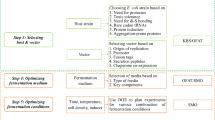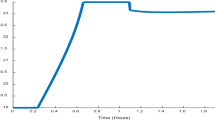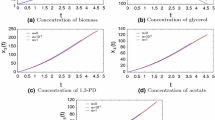Abstract
A nonlinear model of a recombinant Escherichia coli producing porcine growth hormone (pGH) fermentation was developed. The model was used to calculate a glucose feeding and temperature strategy to optimize the production of pGH. Simulations showed that the implementation of optimal feed and temperature profiles was sensitive to the maximum specific growth rate, and a mismatch could result in excessive acetate production and a significant reduction in pGH yield. An optimization algorithm was thus developed, using feedback control, to counter the effects of uncertainty in the specific growth rate and thus determine an optimal operating strategy for pGH production. This policy was experimentally implemented in a 10 L fermenter and resulted in a 125% increase in productivity over the previous best experimental result with this system—in spite of significant plant-model mismatch.





Similar content being viewed by others
References
Jeong JK, Lee SY (1999) High-level production of human leptin by fed-batch cultivation of recombinant Escherichia coli and its purification. Appl Environ Microbiol 65(7):3027–3032
Bech Jensen E, Carlsen S (1990) Production of recombinant human growth hormone in Escherichia coli: expression of different precursors and physiological effects of glucose, acetate, and salts. Biotechnol Bioeng 36:1–11
Cockshott AR, Bogle IDL (1999) Modelling the effects of glucose feeding on a recombinant E. coli fermentation. Bioprocess Eng 20:83–90
Montague G (1997) Monitoring and control of fermenters. Institution of Chemical Engineers, UK
Johnston WA, Cooney MJ (2001) Implementation of an integrated control structure in a fed-batch fermentation system for recombinant E. coli. IFAC CAB 8, IFAC/Elsevier, pp. 201–206
Wong HH, Kim YC, Lee SY, Chang HN (1998) Effect of post-induction nutrient feeding strategies on the production of bioadhesive protein in Escherichia coli. Biotechnol Bioeng 60(3):271–276
Kuhlmann CH, Bogle IDL, Chalabi ZS (1998) Robust operation of fed batch fermenters. Bioprocess Eng 19(1):53–59
Tartakovsky B, Dainson BE, Lewin DE, Sheintuch M (1996) Observer-based non-linear control of a fed-batch autoinductive fermentation process. Biochem Eng J 61:139–148
Volk N, Hertel A, Lubbert A (1998) Modellgestüze Optimierung Der Produktion Des Virus-Hullproteins Vp1-DHFR mit E.coli Bl21. Chem Technik 4:192–197
Franco-Lara E, Galvanauskas V, Volk N, Lubbert A (2001) Model-based optimization of the cultivation process for recombinant virus capsid proteins in E.coli. IFAC CAB 8, IFAC/Elsevier, pp. 305–309
Levisauskas D, Galvanuskas V, Henrich S, Wilhelm K, Volk N, Lubbert A (2003) Model-based optimization of viral capsid protein production in fed-batch culture of recombinant Escherichia coli. Bioprocess Biosyst Eng 25(4):255–262
Borth N, Mitterbauer R, Mattanovich D, Kramer W, Bayer K, Katinger H (1998) Flow cytometric analysis of bacterial physiology during induction of foreign protein synthesis in recombinant Escherichia coli cells. Cytometry 31(2):125–129
Mattanovich D, Kramer W, Luttich C, Weik R, Bayer K, Katinger H (1998) Rational design of an improved induction scheme for recombinant Escherichia coli. Biotechnol Bioeng 58(2 and 3):296–298
Kavanagh JM (2003) Studies in the optimization of recombinant Escherichia coli. PhD Thesis, University of Sydney
Glassey J, Kara B, Ward AC, Montague G (1994) Enhancing fermentation development procedures via artificial neural networks. Biotechnol Bioeng 44(4):397–405
Barton GW, Kavanagh JM, Malik RK, Romagnoli JA, Doan TX, Fermenter modelling of a non-induced E. coli producing porcine growth hormone, IFAC CAB 8, Quebec city, Canada, 2001
Barton GW, Kavanagh JM, Malik RK, Romagnoli JA, Doan TX, Optimization of recombinant E. coli, World Congress of Chemical Engineering, Melbourne, 2001
de Andreas-Toro B, Giron-Sierra JM, Lopez-Orozco JA, Fernandez-Conde C, Fernandez Blanco P (1998) A fast genetic optimization for batch fermentation processes, IFAC CAB7, IFAC/Elsevier, pp. 61–66
Author information
Authors and Affiliations
Corresponding author
Rights and permissions
About this article
Cite this article
Kavanagh, J.M., Barton, G.W. Productivity improvement of recombinant Escherichia coli fermentation via robust optimization. Bioprocess Biosyst Eng 31, 137–143 (2008). https://doi.org/10.1007/s00449-007-0156-6
Received:
Accepted:
Published:
Issue Date:
DOI: https://doi.org/10.1007/s00449-007-0156-6




